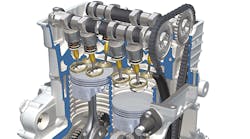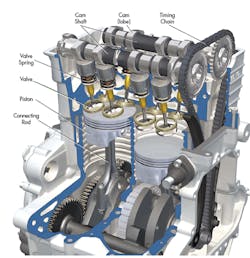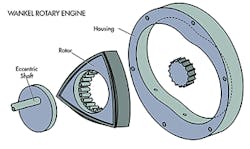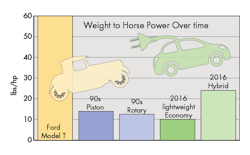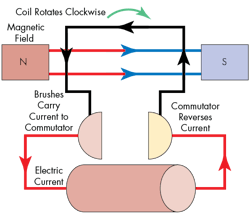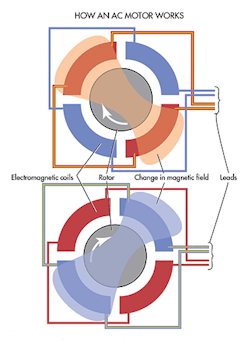This file type includes high resolution graphics and schematics when applicable.
Automotive engineers are concerned with weight-to-power ratios when designing vehicles. While light-weighting is a strong focus within the industry, researchers are also looking at more efficient engine design. The internal combustion (IC) engine is currently the engine of choice for vehicles, but the growing concern regarding climate change has given electric vehicles increased attention over the years.
Understanding the difference between these engines and how they affect resources—not to mention, the weight-to-power ratio—reveals key properties that might indicate when or if the IC engine could be in decline.
Piston IC Engine
The efficiency of the piston engine, in general, is around 28 to 45%. It can have hundreds of moving parts that can be the source of more maintenance, noise, and energy losses than in rotary or electric engines, which have fewer parts and less complexity. Despite these issues, the weight-to-power ratio is keeping IC piston engines on top—for now.
The most common engine on the road today is the four-stroke IC piston engine. Each stroke performs a task in a combustion cycle that rotates the crankshaft or driving shaft. With each stroke, the piston travels from top dead center (the top-most position the piston can reach in the cylinder) to bottom dead center (the bottom-most position).
The first stroke, the intake or induction stroke, draws air and fuel into the cylinder. In diesels, this stroke only draws in air; the fuel is injected just before the power stroke. As the piston returns to the top, it compresses the mixture; a spark plug then ignites it. Diesel engines have higher compression ratios that generate higher temperatures, thus causing combustion when fuel is injected without a sparkplug. Diesel engines have heating elements, called glow-plugs, where the sparkplugs are located that help warm up the combustion chamber for cold starts.
The fuel/air mixture is ignited during the next stroke, the power stroke, and the expanding gases from the small explosion force piston to bottom dead center. Finally, the fourth stroke, the exhaust stroke, returns the piston to top dead center and pushes gases out of the cylinder.
The pistons’ linear moments are translated into rotary motion through connecting rods that turn the crankshaft. In turn, the crankshaft drives the transmission. The crankshaft also connects to the camshaft(s)—normally with a belt, though sometimes a rolling chain is used. The camshaft rotates the cams to open and close valves, controlling the timing of the intake and exhaust of gases in the cylinders.
To get the most power out of each stroke, designers focus mainly on the pistons, cams, and valve design. Performance and efficiency improvements often rely on increasing the speed or rpms and pressures on these components. This can be challenging: Something as simple as increasing pressure during compression strokes (e.g., the compression ratio) could require a completely new cylinder head, pistons, and connecting rod made from materials that withstand the higher stresses. Higher stresses also might demand higher octane fuel for proper ignition. Ignoring any of these issues can lead to excessive wear on the engine and inefficient operation.
Rotary IC Engine
A rotary engine—specifically, the Wankel rotary engine—does not have pistons, but rather, a three-lobed triangular rotor. The key differences from a piston engine are the reduction of parts, reduced vibration, and the ability for the motor to perform at high speeds (rpms). The engine comes in a relatively small package with a high power-to-weight ratio. Compared to piston engines, the rotary engine’s simple concept and complex geometry has sparked some passionate debates as to why it isn’t more popular.
To envision the inside of a rotary engine, it is first necessary to know what an epitrochiod is (also called an epicycloid). Epitrochiods are geometric shapes formed by tracing a point along a radius of a shape that is rolling out or inside another shape. If you have ever used a Spirograph, you were playing with epitrochiods. A rotary engine’s housing is a simple epitrochiod of two circles. The rotor spins eccentrically inside the housing, thus changing the volume of three spaces (chambers) formed between the two.
Rotary engines share the same four-stroke sequence of piston engines: intake, compression, power, and exhaust. The rotor’s rotation increases the volume of the first chamber drawing in air and fuel—the intake stroke. As the rotor continues to turn, the volume in the chamber shrinks, compressing the contents of the chamber causing the compression stroke. A problem at the next step is the geometry between the housing and rotor separates the chamber into two spaces. This elongated and separated ignition chamber can hinder complete combustion as some of the air/fuel mixture is cut off from a spark plug.
To help, there are either two spark plugs, or one spark plug with an exclusion or divot in the rotor to let the mixture into both spaces of the chamber. Normally, two spark plugs are used and Mazda has even used three spark plugs in its racing cars. Expanding gasses rotate the rotor further into the expansion or power stroke. Eventually, the expansion drives the rotor around to where there is an exhaust port in the housing. The volume between the housing and rotor shrinks again, pushing exhaust gases out of the chamber—the exhaust stroke.
Rotary engines do not have to transfer linear to rotary motion, eliminating violent changes in direction pistons must make, so rotary engines generate much lower vibrations. The rotary design also lets the power stroke operate over a longer rotation of the shaft, thus reducing sporadic torque on the crankshaft (from ignition to exhaust there is about 270 deg. of rotation, versus 180 deg. on piston engines). Ultimately, a single rotor in a rotary engine is comparable to a three pistons in reciprocating engine. Rotary engines often have two rotors for smooth operation and are comparable to V6 engines.
As early as the 1960s, some auto executives and observers thought rotary designs would become the design of choice for cars and trucks. But Mazda, the first company to mass produce rotary engines, stopped production after 2012. Mazda said unless the company could justify annual production of 100,000 units, the Wankel engine would not be manufactured again. However, research to improve the engine is still underway.
With so many benefits, what happened to the rotary engine? A rotary engine can operate with as little as three moving parts, making it simple and easy to maintenance. Basic piston engines have at least 40 moving parts. This led to some conspiracy theories about how a car with so few parts would lose car part companies millions. But a better argument for piston over rotary engines is made over the complex seals, low-end torque, and thermal efficiency.
Although Mazda addressed some problems, there was still some cross-chamber contamination and unintentional oil consumption that led to emission and efficiency problems. As regulation for emissions got tighter, the rotary vehicles suffered. In addition, the crankshaft rotates three times per single rotation of the rotor. This 3:1 ratio does not deliver competitive low-end torque (compared to a piston engine). This is why rotary engines are great for mid to high-end applications, such as planes, marine, and race cars—but not for daily commuters.
Thermal efficiency of rotary designs is reduced due to the larger surface area (compared to piston engines) in the combustion chamber. This lets heat escape into the housing and rotor. It should also be noted that about a third of a rotary engine’s cooling is done with oil, hence oil cooling is mandatory. Emissions are another problem with rotary engines. For example, the last production RX-8 engine cannot meet current mission standards, so current design wouldn’t be able to be made today without emission improvements.
The benefits of the rotary engines—reduction of parts and vibrations—may have been what led to some companies into researching opposed-piston/opposed-cylinder (OPOC) engines. These are piston engines with pistons along the same plane, but in opposing cylinders. With four pistons operating in two opposing cylinders and in direct opposition, vibrations are lowered by balancing the reciprocating forces with the adjacent piston. This also increases the combustion stroke to once every rotation of the crank shaft rather than every other rotation, as seen in traditional piston engines.
In 2010, Ecomotors said it could get four times the power from an OPOC two-stroke engine as a four-stroke engine of the same mass. One way this was accomplished was by reducing the number of parts. A 300-hp OPOC engine consists of 62 moving parts. A conventional engine with similar power has around 385 moving parts. Also, the opposing forces mean there is no (or nominal) forces on the main crankshaft bearings. And with lower forces, designers could make the housing out of lightweight magnesium.
Electric Engines
It can be hard to find accurate efficiencies rating for electric vehicles (EV). While the motor can be 85 to 95% efficient, once the power goes through the inverter, battery, and charger, EV efficiency is closer to 70%. However, electric engines and batteries can be relatively sensitive to hilly terrain, and temperature changes that could reduce the efficiency even father. So with higher efficiencies than IC engine, essentially no moving parts in the engine, zero emissions, and the ability to use regenerative braking to increase efficiencies by 9 to 16% (as published in the study), why are EV sales lower than some auto analysts thought they would be?
In general, the limited driving range, battery charging time, and higher prices keep EVs just out of the grasp of the average person. From a technology standpoint, the main flaw in EVs is the battery. Lithium-ion batteries are the most powerful mass-produced battery. But they are heavy, expensive, and have the ability to overheat to the point of thermal runaway (catching on fire). Most new battery technologies are geared towards lower voltages common in AA batteries. These innovations are not scalable for vehicles applications.
There are two types of electric engines used in EVs: brushless DC motors and three-phase induction AC motor.
DC Motors operate off a coil or loop suspended between the poles of a magnet. A direct current of electricity generates a temporary magnetic field, causing it to turn and align with the polarity. An electrical switch (commutator) then reverses the current, changing the polarity. This keeps the coil rotating indefinitely.
Simply Explained
Some of the advantages of DC motors include immediate high torque, and they are relatively cost-effective. On the downside, they should not be run without a load, as it could damage the motor. That is why running a DC motor to turn a belt could be a poor design. If the belt brakes, there is no load and the motor could spin into a catastrophic failure. DC motors are also are not ideal for maintaining speed over varying load conditions—e.g., an EV with this motor might not perform well in hilly terrain. And while adjusting the voltage can control DC motor speed, the motor has a maximum rpm rating beyond which it cannot go, so peed is inherently limited.
AC motors use a ring of laminated metals to generate a magnetic field when AC current is applied. The electromagnets encircle a rotor. The AC causes the strength the electromagnets’ magnetic field to rise and fall, creating a shifting magnetic field that generates torque.
AC motors offer higher torque and speeds, compared to DC. They also are more adaptable to variable speed and loads, so it works better for hills. It also accepts energy from regenerative braking easier than a DC motor. But the coil winding can be heavy, and an inverter is necessary when using batteries. In general, an AC motor’s overall cost is higher than that of a comparable DC motor.
Over all there are automotive and off-road applications for AC and DC motors. But to make electric motors and EVs viable it will take major advances in battery technology. The current energy storage necessary to power EVs adds too much weight, making the weight-to-power ratio too high. There are also the problems of slow recharging and environmentally clean disposal.
A cradle-to-grave analysis published by the Union of Concerned Scientist shows that an EV with an 84-mile range creates about 15% more emissions to manufacture than a conventional car. This difference could be recouped in a year of driving, and the car will emit half as many pollutants over its lifetime—including manufacturing. So as deals, such as the Paris Accord, are passed move towards a carbon neutral society over the coming years, we might see more EVs on the road.
However, like many technologies, multiple are needed to achieve optimal efficiency. Due to the current state of batteries smaller IC engines are pairing with electric drive technologies that are making even the emission standards of 2025 (54.5 mpg) sound easier to hit than some may have initially thought. If hybrid innovations for the IC engine design are not improving the performance and growth of the piston engine, it is at least increasing the slope of its diminishing return and extending the IC engines existence—at least, for now.
This file type includes high resolution graphics and schematics when applicable.
